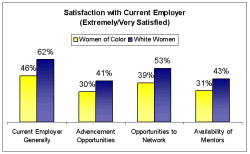See also: Ways to Retain Women of Color
 A lot has been made of the glass ceiling that prevents women from reaching the highest echelons of corporate and professional America, which includes law firm leadership. But according to a new study by Catalyst, a nonprofit research and advisory group, for women of color in the legal profession that glass ceiling can seem more like concrete. At the same time, though, success stories from women of color can point the way for both other women of color and their employers.
A lot has been made of the glass ceiling that prevents women from reaching the highest echelons of corporate and professional America, which includes law firm leadership. But according to a new study by Catalyst, a nonprofit research and advisory group, for women of color in the legal profession that glass ceiling can seem more like concrete. At the same time, though, success stories from women of color can point the way for both other women of color and their employers.
When Catalyst profiled more than 1400 graduates (from five top law schools) for its study Women in Law: Making the Case, they found that roughly 70 percent of the men and women profiled, regardless of race, began their careers in law firms. But of those, only 35 percent of women of color and 41 percent of white women are still practicing in law firms, compared to 51 percent of men. In addition, more than one-third of women of color plan to leave their current employer within the next three years.
 While attrition among women of color is often cited as the reason for the lack of diversity in firms, the study found that attrition is a symptom, not a cause. The cause of attrition among women of color has to do with their perceptions of advancement opportunities. Overall, women in general are less satisfied than men with advancement opportunities in the legal field, but women of color are the least satisfied. Women of color are also least satisfied with the availability of mentors and opportunities to network with influential clients and colleagues. This finding is consistent with the 1999 Catalyst Women of Color in Corporate Management study, which found that lack of an influential mentor and lack of informal networking with influential colleagues were the top two barriers to advancement cited by women of color.
While attrition among women of color is often cited as the reason for the lack of diversity in firms, the study found that attrition is a symptom, not a cause. The cause of attrition among women of color has to do with their perceptions of advancement opportunities. Overall, women in general are less satisfied than men with advancement opportunities in the legal field, but women of color are the least satisfied. Women of color are also least satisfied with the availability of mentors and opportunities to network with influential clients and colleagues. This finding is consistent with the 1999 Catalyst Women of Color in Corporate Management study, which found that lack of an influential mentor and lack of informal networking with influential colleagues were the top two barriers to advancement cited by women of color.
"One of the reasons you leave the private sector is because they don't give you the responsibilities or high profile cases," said one Asian-American lawyer, who is now working for a nonprofit organization. As an African-American woman partner explained, "We talk about the strides women have made in the profession, but I don't think the same amount of success has been found by women of color. Women of color do not get the same breaks and opportunities."
While the women of color studied were younger than the white women, and more likely to be single with no children, work/life conflict also factored into the decision to leave. As one single, African-American female partner said, "I woke up one day and thought, 'Gee, I'm getting older and I've been practicing law all this time. I'm never going to have any fun unless I make it a point to live my life.'" Unlike other sectors Catalyst has studied, both white women and women of color identify commitment to family as the number one barrier to women's advancement in the law.
Why should law firms and other legal employers care about retaining and advancing women of color? Since losing one person costs employers 150 percent of salary, the disproportionately high turnover rate among women of color hurts companies' bottom lines. Not only are clients well aware of this cost, but they are also concerned about diversity and stability in their service teams.
Many legal employers have accepted the attrition of women of color as a foregone conclusion, but there are ways to retain and advance this valuable source of talent (see article). Women of color must also take the initiative to create opportunities. An African- American woman partner at a large New York firm felt that, as an associate, she wasn't getting the visibility she needed to advance. So she volunteered to serve on a newly formed diversity committee, and credits her promotion to partner in some degree to the relationships she made serving on that committee.
Another African-American woman partner describes how she capitalized on people of color and women's networks. "I picked up a copy of the Directory of African-American Lawyers and circled all the in-house lawyers and picked up the phone." Very quickly, she was having lunch with an African-American general counsel of a large transportation authority, who described how his head of litigation wasn't happy with how a case was being handled. Later, she researched the case, and then wrote the head of litigation explaining how she would handle the matter differently. She has been the agency's lead outside counsel ever since.
Breaking down the concrete barrier for women of color may be a challenge, but legal employers that rise to that challenge will be rewarded with lower turnover, a healthy bottom line, and a team that reflects the demographic of the twenty-first century.
Anne Weisberg, Esq. and Meredith J. Moore were the senior research associates on Catalyst's study, Women in Law: Making the Case. Catalyst is a nonprofit research and advisory organization working to advance women in business and the professions, with offices in New York and Toronto. For additional information, visit: www.catalystwomen.org or call 212.514.7600.
From the March 2002 issue of Diversity & The Bar®
